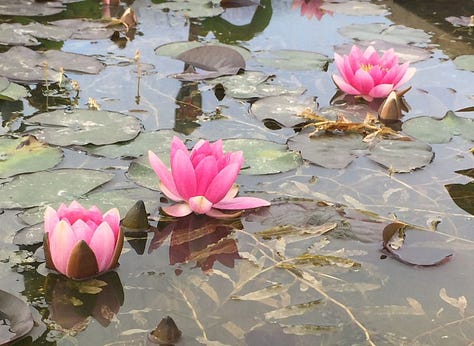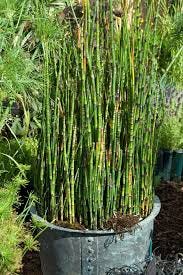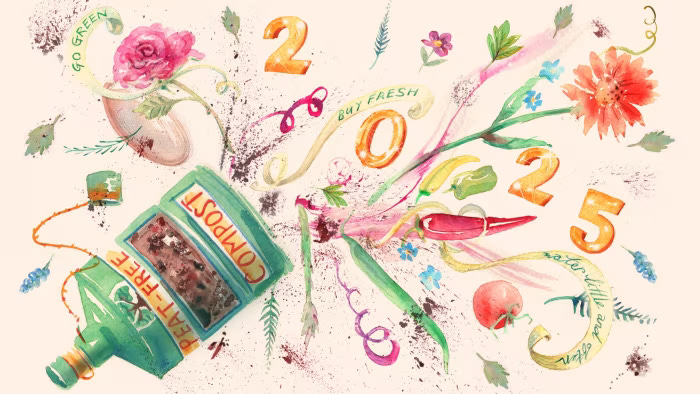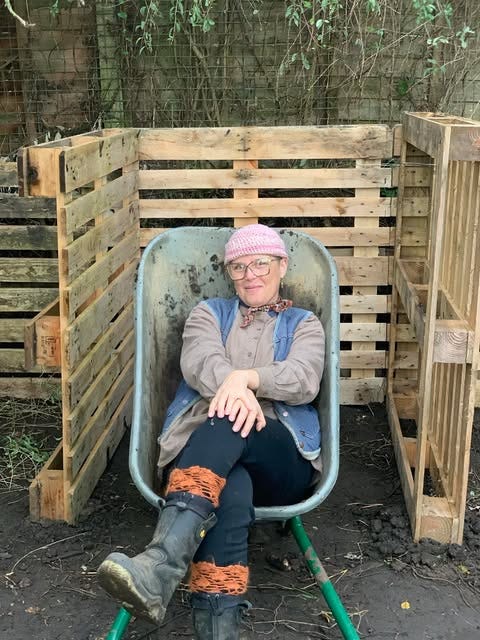APRIL 2025: BLOSSOM, SNOW!
C is for Compost, the decomposed gold made of biodegradable materials.
It is hot stuff!
And you can make it for free!
Instead of shipping off garden and kitchen waste (in a bizarre extractive and single use kinda way), hang on to dead leaves, grass-cuttings, weeds and vegetable peelings. Nature does not put its clippings and cuttings into a black plastic bag. Make it into a pile, invite the worms, beetles, bacteria and fungi over, and once they’re done partying, your compost is done too, ready to be applied to the garden as an organic fertiliser, soil conditioner or planting medium. Gratis!
This needs more exclamation marks!!!!!
Should composting tickle your organic gardening fancy, further below is an expert HOW-TO article describing easy DYI ways for making compost magic. Just take out a monthly or annual subscription to unlock the knowledge, with additional external advisory, informative and supplier links.
The
April newsletter is blooming with encouraging tidbits of information, some ranting, hopeful news about growing, a podcast, the monthly playlist, local dates for your diary, plus that step-by-step composting guide.Welcome to new supporter
, procrastigardinator by his own definition, opera singer and joyful gardener to the rest of us. We’ve been co-working on renovating the family pond since autumn, somewhere in Upper Walthamstow. Last week Tuesday the plants went in! Yellow flag irises, a water lily, Dutch rush, and more.


As I am writing the back door is open, letting in fresh air, bird song and a very loud buzzing noise. It lingers by the door, I can hear it move closer. The hand crocheted brocante curtain is tightly pulled across, to keep buzzing things out, yet I am still disturbed by the volume level of this sound. Will it wiggle it’s way in? I stand up to check and spot a fat, fluffy bumble bee hovering by the back of the house. A few times it attempts to fly forward, bouncing off the window pane. Unsuccessful, it drops it’s furry self down to inspect a plant pot pile under my work bench instead.
She may be a queen, newly emerged from hibernation as the sole survivor of her kind, in search of a location for her forthcoming colony. Every nest starts with a single bumblebee queen. Common places include long tangled grass, compost heaps, bird boxes, and abandoned mouse and vole holes, or perhaps my dining room?
I should have recorded her sound, but I didn’t. Instead I watched her bumble through the air. Serendipitously, the April podcast ‘As The Season Turns’, for perfume house Ffern, did record that buzzing sound, to tell a beautiful story of bumblebees and interconnectedness in our gardens. Now in it’s 5th cycle (year), the monthly almanac-style audio piece, presented by
ABOUT ALMANACS
As a child I recall seeing a small booklet, with a red printed farmer’s torso in traditional clothing on the front, lying around our home in the Beemster polder. It was called De Enkhuizer Almanak. I’d browse it, not understanding what information was shared, nor why. Still published to this day, the Enkhuizer Almanak is the world’s oldest surviving almanac, now in it’s 430th edition (based on known, existing copies). It has its own website, in Dutch. I can translate that for you, over a small glass of advocaat.
These were important publications. In England they were ubiquitous too. It is estimated that one existed in every third household by the 1660s. Marking events in a religious calendar, alongside important naturally occurring phenomenon such as the position of the moon and planets, or the tides of the seas, helped different agricultural communities to mark important dates, seasons and related activities. For example, if the local cattle market happened every full moon, you’d know from the sky when that was, correlate that with the almanac, and make your way to town, herd of sheep in tow. Almanacs were ephemeral, discarded each year in December, used to light a fire or tossed down the privy. No wonder not as many early copies survive.



A RANT
Less fancy is the disappointing news that the RHS has done a U-turn on their ‘becoming peat-free by 2025’ pledge. Three months into this promised peat-free year they have now backtracked on peat use at RHS shows: “RHS Floral shows, show gardens, judged displays and trade stands are to be 'no new peat plants'. However, in the marquee in 2026 nurseries will be able to sell plants started in plugs containing peat but not grown on in peat for the next three years. The RHS says they have changed their mind and made their decision to allow peat use for three extra years because there is no legislation, and that they need Government to step in as most of the industry's young plant material is predominantly bought in from overseas, where peat is the norm. There is no Government ban date… growers and designers at shows can still use 'legacy peat' for plants planted before the ban comes.”
While worded sensibly, don’t be fooled: no one should be using peat ever again. It may be difficult to suppress the temptation to buy pretty plants when visiting nurseries, imported from the continent, grown in peat, but you as a consumer CAN make better decisions by ordering plants from independent UK nurseries that are already growing peat free. Ring them up, or send an email, to ask how they grow, delay your plant buying fix, support UK independent businesses, and if you must scratch that itch, shop at B & Q where their labels state the percentage of peat used in different plants. Obviously you choose peat free. Nothing that we, as capitalist humans, wish for in our gardens is that important that it justifies the ongoing destruction of peat bogs. If you need an explainer, James Wong’s article in the Guardian from 2021 tells all.
My position on extractive gardening practices is so bound up in ethical garden ing considerations that I have, as a result of the u-turn, declined a paid planting job on a wildlife garden at the RHS Hampton Court Show in June. Initially I was flattered, because this would have been my third year of being involved with a show, but paid, building skills, forging professional connections, scaffolding my status (and a bit of ego) but after reading the Wild Way Substack by
What can be used instead? For one, home-made compost, which I write about for paid subscribers below. HERE is a generous article giving you different options. Or you can book me to guide you through the maze of ethical gardening, organic growing and plastic-free, loop-based systems. Email on studio.schipper@gmail.com to book a date. We can co-garden, working on this gently, kindly, together.
NEWS:
(all hopeful)
- Traveling: three times lucky, I have finally managed to book a working holiday on an organic farm near Perpignan, in La Douce. I will be helping Ursula et Vincent growing gourds for making musical instruments out of, in lieu of bed & board. I discovered their little growing spot La Ferme Musicale on the French WWOOF website in 2020. Back then the pandemic got in the way. Last year they were fully booked with volunteers already. Not this June! WWOOF is the Worldwide Organisation of Organic Farms. It’s a working holiday platform promoting sustainable farming since 1971, worldwide. One day I might make it to Japan…. once I master the language. Note to self: the Japanese word for gourd is ひょうたん (hyōtan).
- Volunteering: Plot E17 Community Orchard, at Higham Hill Common Allotments, will be running monthly dates for anyone age 16 or over to gather on that little bit of land for growing veg, encouraging wildlife and drinking tea. The next date on the plot is Sunday 27.04 , between 10am - 2pm. To get involved you can join our WhatsApp community HERE or you can email plote17communityorchard@gmail.com to be added to the volunteer mailing list.
- Learning: in addition to providing City & Guilds qualifications in Horticulture through food growing, OrganicLea is also offering workshops in mushroom cultivation, seed sowing, fruit care & pruning plus you can visit their site for the Open Days, with plant sales, in Chingford. The first one of the season is on Sunday 27.04.25
- Walking: Nourish The Wild is hosting a Radical Plant Walk right on our Walthamstow doorsteps in Lloyd Park on Sunday 27.04.25 from 10:30am - 12pm. Explore your local plantscapes in the fullest sense, weaving botany, horticulture, foraging and activism to inspire food system change. Donation tickets HERE.
- Campaigning: Waltham Forest deserves a Right to Grow! This campaign is made up of people who are experienced growers, who are organising a local food movement with a credible alternative to the current system that is letting us humans and nature down. Over the next 6 months the campaign will connect interested people and identify land suitable for food growing, while demanding that LBWF commits to a serious, accessible food strategy. There is a fundraiser to generate money for paying part time coordinators and supply new gardens HERE. To show our council how many of us want a right to grow in our borough there will be an afternoon of eating, crafting, seed swapping and learning in front of the council town hall on Forest Road on Saturday 12.04.25 from 12pm-4pm. Everyone’s welcome with activities for kids too.
MUSIC
This April, the Music-To-Garden-By playlist is also a Music-To-Drink-Coffee-By selection, in collaboration with Jaunty Coffee. The coffee folk and music minds at the coffeeshop on 147 Forest Road, E17 6HF, have compiled their own favourite song selection for gentle April living: for reading a book, sipping a latte, hugging friends, journaling, watching the world go by, and always, also, for gardening. A warm thank you goes out to Donny, Thalia, Ali, Jana and me,
GENTLE TO-DO, OR NOT-TO-LIST
- deadhead your daffodils by gently snapping off the spent flower heads where the stem ends, near the flower, so energy can go into feeding the bulbs for next year. This goes for all returning bulbs each Spring season. Don’t cut, or tie in knots, leave the leaves to yellow and die back because they are supporting the bulbs underground.
- brew an energising Spring tonic by foraging for dandelions, cleavers while they are young. Full instructions HERE.
- start weeding while they are small. This way the less desirable wild plants won’t take over the more desirable ones.
- if you’re a lawn person, you’ll have made the first cut, on a high setting. Now it’s time to bring the setting down, for a closer cut. Set grass aside for mulch or compost.
- sit under a blossom tree, to gaze, and wonder, about the fleeting nature of life
HOW-TO COMPOST
What on earth even is compost? It can be a part of earth, mixed into it. Compost is made from biodegraded, rotted down garden and kitchen waste. It includes dead leaves, grass-cuttings, weeds and vegetable peelings, for example. Over time the organic waste matter is broken down by worms, beetles, bacteria and fungi. Once the compost is formed, all dark and crumbly and smelling earthy, the nutrients in the waste have been recycled. Homemade compost can then be used in the garden.






